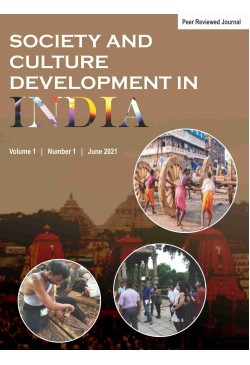
Society and Culture Development in India
Frequency :Bi-Annual
ISSN :2583-0694
Peer Reviewed Journal
Contents and Editorial Note
Performance of Elected Dalit and Non-Dalit Women Representatives in Panchayats with special reference to Kancheepuram district, Tamil Nadu
Lakshmi, A.P. (2023). Performance of Elected Dalit and Non-Dalit Women Representatives in Panchayats with special reference to Kancheepuram district, Tamil Nadu, Society and Culture Development in India, 3: 1, pp. 1-10. https://doi.org/10.47509/SCDI.2023.v03i01.01
Damage and the Reparation: CSR and Environmental Sustainability
Pandey, A., & Dubey, B.N. (2023). Damage and the Reparation: CSR and Environmental Sustainability, Society and Culture Development in India, 3: 1, pp. 11-19. https://doi.org/10.47509/SCDI.2023.v03i01.02
Hurtling towards Nuclearisation: Sociological Reflections on the Transforming Patterns of Family as a Social Institution
Priya, A. (2023). Hurtling towards Nuclearisation: Sociological Reflections on the Transforming Patterns of Family as a Social Institution, Society and Culture Development in India, 3: 1, pp. 21-28. https://doi.org/10.47509/SCDI.2023.v03i01.03
A Comparative Identity of Maithili and English Language through Linguistics Approach
Thakur, D.K., & Thakur, R. (2023). A Comparative Identity of Maithili and English Language through Linguistics Approach, Society and Culture Development in India, 3: 1, pp. 29-41. https://doi.org/10.47509/SCDI.2023.v03i01.04
Victimisation or Survival?: Disaster Vulnerability and Adaptation among Sri Lankan Urban Women
Madhushani, D., & Abeywardhana, Y. (2023). Victimisation or Survival?: Disaster Vulnerability and Adaptation among Sri Lankan Urban Women, Society and Culture Development in India, 3: 1, pp. 43-60. https://doi.org/10.47509/SCDI.2023.v03i01.05
Environmental Social Work: A Path towards Sustainable Development
The repercussions of ecological crises and shortage of natural resources have strongest impact on the most vulnerable and marginalised sections of the society. The impact is seen pertinently in the areas of space, food, energy, health and recreation. Sustainable development as an umbrella concept provides a scope to establish linkage between physical environment and social milieu, human being and issues of ecological and social sustainability. The broad objective of the present research is to find out how Environmental Social Work can contribute to sustainable development and to explore what roles social workers can play to fulfil the needs of the people without compromising the ability of the future generation to meet their needs. The article tries to analyse the environmental issues and concerns of the contemporary society and explore possible ways in which social workers can be involved in dealing with the environmental issues at different levels. The current research makes use of explorative and descriptive research design to establish linkages between environmental social work, ecological sustainability and sustainable development. Available literature on sustainable development and Environmental Social Work has been collected and synthesised to critically analyse how environmental social work practice can play pivotal role committing towards sustainable development. It also briefly highlights the environmental social work practices in India and the contribution of Indian social work practitioners to handle the environmental challenges. The research finds that a holistic analysis of the contexts of the resources and problems of individuals and communities is highly needed. It emphasises on the seminal role of inter-disciplinary approach in bringing sustainable development through Environmental Social Work. The research suggests that in the context of the new knowledge available about ecological sustainability, application of ‘community organisation’ and ‘social action’ methods can be highly applicable for the environmental social workers to ensure sustainable development.
Keywords: Sustainable Development, Environmental Social Work, Inter-Disciplinary Approach
Biswal, M. (2023). Environmental Social Work: A Path towards Sustainable Development, Society and Culture Development in India, 3: 1, pp. 61-76. https://doi.org/10.47509/SCDI.2023.v03i01.06
Utilisation and Conservation of Biodiversity by Indigenous Tribes in Similpal Biosphere Reserve, Odisha, India
Sahoo, M. (2023). Utilisation and Conservation of Biodiversity by Indigenous Tribes in Similpal Biosphere Reservem, Odisha, India, Society and Culture Development in India, 3: 1, pp. 77-91. https://doi.org/10.47509/SCDI.2023.v03i01.07
Dimensions of Social Welfare vs Public Welfare in Asia: A Sociological Appraisal
Sheykhi, M.T., & Codina, M.R.B. (2023). Dimensions of Social Welfare vs Public Welfare in Asia: A Sociological Appraisal, Society and Culture Development in India, 3: 1, pp. 93-103. https://doi.org/10.47509/SCDI.2023.v03i01.08
Performing as Critical Resistance in Contemporary Times
Kalra, P. (2023). Performing as Critical Resistance in Contemporary Times, Society and Culture Development in India, 3: 1, pp. 105-122. https://doi.org/10.47509/SCDI.2023.v03i01.09
Indian Working Professionals in the COVID-19 Lockdown Situation
No doubt, the novel coronavirus has created turmoil stagnation around the globe; its threat to infect people segregated as well as intensely affected all the working sectors. The working professionals are under varied socio-economic as well as psycho-social pressure for the members of their primary social units as well as earnings to a safe life. In a situation, many of the working professionals are removed from the jobs, many are fighting to cope with the challenges of ‘work from home’ with digital medium. The paper is tried to elaborate the, nature of cope with such disruptive situation to keep stabilise the social institutions of India as ‘functional’ by the working professionals.
Keywords: Lockdown, Working professionals, Digital medium, COVID-19
Participation and Development: Reflections from a Rajasthan Development Block
Singh, S.B. (2023). Participation and Development: Reflections from a Rajasthan Development Block, Society and Culture Development in India, 3: 1, pp. 159-170. https://doi.org/10.47509/SCDI.2023.v03i01.11
Book Review: Tribal Health: Perception And Realization